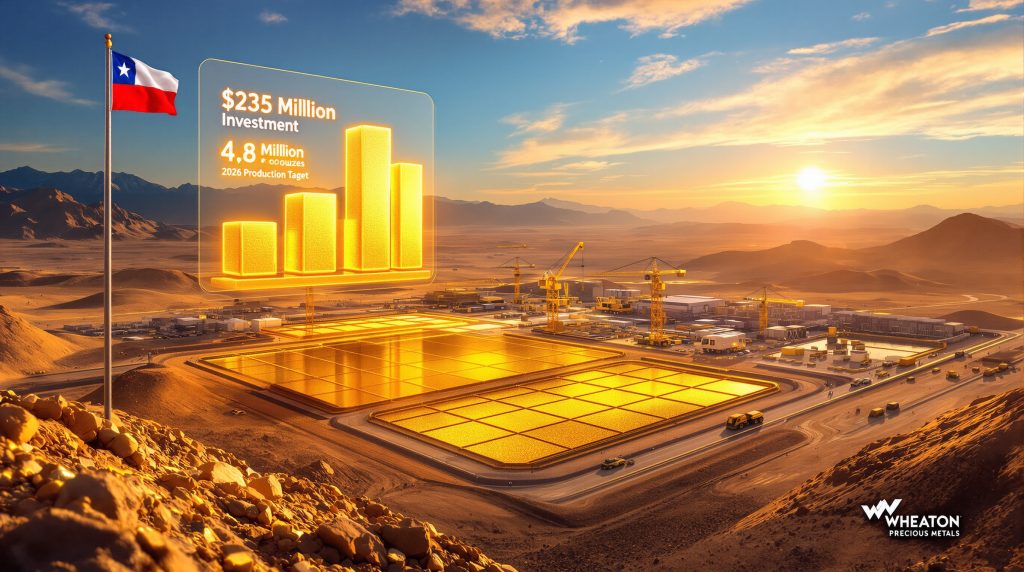Strategic Mining Development in Chile's Atacama Region
The global gold mining landscape is experiencing a significant shift as major development projects advance toward production in established mining districts. Chile's Atacama Region has emerged as a focal point for strategic mineral development, with new projects positioned to enhance the country's competitive standing in international markets. The rio2 chile gold project represents a technological evolution through its run-of-mine heap leach processing approach that addresses both economic efficiency and environmental considerations in modern gold extraction operations.
Rio2's Fenix gold development exemplifies this trend, with a 4.8 million ounce resource base representing substantial mineral wealth in one of Chile's most established mining corridors. The project's classification among the Americas' largest undeveloped oxide heap leach operations reflects the strategic importance of scale in contemporary mining economics. Furthermore, market timing factors have aligned favourably for new gold production capacity as institutional investors seek exposure to fully-funded development projects with proven resource bases, particularly given the current gold prices analysis.
Wheaton Precious Metals Partnership Structures Modern Mining Finance
The completion of Wheaton Precious Metals' $50 million final investment tranche demonstrates the evolution of mining project financing through precious metals purchase agreements. This structured approach represents a four-year capital deployment strategy, with the total $235 million project investment distributed across development phases to optimise risk management and construction execution.
Precious metals purchase agreements have become increasingly sophisticated financial instruments that provide development companies with access to capital while offering streaming companies exposure to production assets. The flexible pre-pay arrangement structure allows for milestone-based funding releases, aligning capital availability with project development requirements. Consequently, this financing model reduces traditional debt service obligations while maintaining operational control for the development company.
Key Financial Milestones:
- Initial agreement establishment: 2021
- Four-tranche payment structure spanning four years
- Final $50 million payment completion: November 2025
- Total project investment requirement: $235 million
- Construction workforce target: 1,200 positions
- Operational employment projection: 550 permanent roles
The staged funding approach reflects industry best practices for large-scale mining developments, where capital efficiency and risk mitigation strategies determine project viability. Moreover, these capital raising techniques demonstrate how Wheaton Precious Metals' participation validates the project's technical and economic fundamentals while providing Rio2 with the financial foundation for construction execution.
Heap Leach Technology Advantages in Arid Mining Environments
Run-of-mine heap leach processing represents a paradigm shift in gold extraction methodology, particularly suitable for oxide ore deposits in water-scarce environments. This approach eliminates traditional crushing infrastructure and tailings storage facilities, significantly reducing both capital expenditure requirements and environmental footprint dimensions.
The technology's environmental advantages extend beyond infrastructure simplification. Traditional gold processing methods require extensive water management systems and generate substantial tailings volumes that necessitate long-term storage and monitoring obligations. In contrast, heap leach operations utilise significantly lower water volumes and produce manageable waste streams that can be more easily integrated into mine closure planning.
Operational Benefits Include:
- Elimination of crushing circuit capital expenditure
- Reduced water consumption compared to flotation methods
- Simplified processing infrastructure requirements
- Lower ongoing maintenance and operational complexity
- Enhanced mine closure planning opportunities
Chile's regulatory framework for mining operations emphasises environmental stewardship and sustainable resource development. The Atacama Region's established mining infrastructure provides logistical advantages while the arid climate conditions actually benefit heap leach operations through reduced precipitation interference and consistent processing conditions. Additionally, effective mining permitting insights are crucial for navigating these regulatory requirements.
Water sourcing strategies in the Atacama leverage both groundwater resources and potential desalination technologies. The region's proximity to coastal areas makes desalinated water feasible for large-scale mining operations, while existing mining districts have developed water management expertise that supports new project development.
Economic Performance Metrics and Industry Benchmarking
The Fenix project's economic fundamentals reflect the current gold market environment and Chile's competitive mining jurisdiction advantages. The 17-year mine life provides substantial production duration while the operational workforce of 550 permanent positions creates significant regional employment opportunities.
Chile's mining sector benefits from established infrastructure networks, skilled workforce availability, and regulatory frameworks designed to support large-scale mineral development. For instance, the Atacama Region specifically offers transportation corridor access, power infrastructure, and proximity to port facilities that reduce operational costs compared to greenfield mining districts.
Production Profile Characteristics:
- Mine life: 17 years of continuous operation
- Resource base: 4.8 million ounces (measured and indicated)
- Processing method: Run-of-mine heap leach
- Employment generation: 1,200 construction, 550 operational
- Regional location: Atacama Region, Chile
The project's economics benefit from Chile's established mining service sector, which provides specialised expertise in areas including metallurgy, engineering, logistics, and environmental management. This ecosystem effect reduces project development risks while enhancing operational efficiency through access to experienced contractors and service providers.
However, gold price sensitivity analysis becomes crucial for long-life mining operations, where commodity price volatility can significantly impact project returns over the operational timeline. The current gold market performance reflects both traditional safe-haven demand and emerging industrial applications that support price stability expectations.
Regional Economic Impact and Employment Generation
The rio2 chile gold project's employment generation extends beyond direct mining positions to encompass broader regional economic multiplier effects. The 1,200 construction positions represent immediate economic stimulus for the Copiapó Province, while the 550 operational roles provide long-term employment stability for local communities.
Mining project employment typically generates additional service sector jobs through supply chain requirements, accommodation services, transportation needs, and professional services demand. The 17-year operational timeline creates sustained economic activity that supports community development and infrastructure investment.
Employment Sector Distribution:
- Direct mining operations: Technical and operational roles
- Construction services: Multiple trade specialisations
- Support services: Logistics, maintenance, administration
- Professional services: Engineering, environmental, legal
- Community services: Healthcare, education, retail
Chilean mining operations emphasise skills development and training programs that enhance local workforce capabilities. These initiatives create career advancement opportunities while building technical expertise that benefits the broader regional mining sector.
Supply chain opportunities for Chilean service providers include equipment maintenance, specialised mining services, transportation and logistics, environmental monitoring, and technical consulting. Furthermore, the established mining district infrastructure reduces the need for extensive new development while supporting efficient project execution.
Tax revenue generation and royalty contributions provide governmental resources for regional development initiatives, infrastructure maintenance, and community investment programs. Chile's mining taxation framework balances resource extraction benefits with public sector revenue requirements.
Chile's Mining Investment Climate and Regulatory Environment
Chile's position as a leading global mining jurisdiction reflects decades of policy development focused on attracting international investment while maintaining environmental and social standards. The country's mining legal framework provides security of tenure, clear regulatory processes, and established dispute resolution mechanisms.
The permitting environment in Chile benefits from specialised government agencies with mining sector expertise and standardised approval processes that reduce development timeline uncertainty. Environmental impact assessment procedures are comprehensive but follow established methodologies that provide predictable regulatory pathways.
Jurisdictional Advantages:
- Political stability and mining-friendly policy environment
- Established legal framework with security of tenure
- Professional regulatory agencies with mining expertise
- Comprehensive infrastructure in established mining districts
- Access to skilled mining workforce and service providers
Chile's currency stability and banking system sophistication facilitate international investment flows and project financing arrangements. The country's integration with global financial markets provides access to capital while maintaining transparent foreign exchange mechanisms.
Regional infrastructure development in the Atacama has been shaped by decades of mining activity, creating transportation networks, power generation capacity, and communication systems that support new project development. This infrastructure base reduces capital requirements while enhancing operational efficiency.
The skilled workforce availability in Chile's mining regions represents a competitive advantage for new developments. Educational institutions, technical training programs, and decades of mining experience have created human capital resources that support efficient project execution and operations.
Global Gold Market Implications and Supply Dynamics
New gold production capacity from established mining jurisdictions like Chile contributes to global supply stability while meeting growing industrial and investment demand. The Fenix project's eventual production will occur within a market environment characterised by both traditional jewellery and investment demand alongside emerging technology applications.
Regional supply dynamics in South America reflect the continent's significant role in global gold production, with established mining districts providing geological prospectivity and infrastructure advantages. Chile's contribution to regional gold output enhances the country's strategic mineral resource position. Consequently, the gold investment outlook remains positive amid these developments.
Market Context Factors:
- Global gold demand trends across sectors
- Regional production capacity and expansion projects
- Technology sector demand for gold in electronics
- Central bank gold reserves and policy implications
- Investment demand through exchange-traded products
The timing of new production capacity reflects market conditions that favour well-financed, technically sound projects in established mining jurisdictions. Institutional investor interest in gold producers has increased as portfolios seek inflation hedge characteristics and commodity exposure.
Rio2's official website provides comprehensive information about the company's strategic vision and project development activities. Additionally, recent construction updates highlight the project's advancement toward production targets.
Toronto Stock Exchange listing provides Rio2 with access to sophisticated mining investment capital and analyst coverage that enhances project visibility among international investors. The Canadian regulatory environment for mining companies offers transparency and disclosure standards that attract institutional participation.
Competitive positioning analysis reveals the Fenix project's scale advantages and jurisdictional benefits compared to development-stage projects in less established mining regions. The combination of resource size, processing technology, and location creates differentiation in the gold development sector.
Risk Assessment and Investment Considerations
Mining project development in arid environments presents specific challenges related to water sourcing, infrastructure maintenance, and operational logistics. The Atacama Region's extreme climate conditions require specialised equipment and procedures while offering the benefit of consistent processing conditions for heap leach operations.
Water availability represents a critical consideration for mining operations in the Atacama, where competition for water resources includes mining, agriculture, and community needs. Desalination technology provides potential solutions while groundwater resources require careful management and monitoring.
Primary Risk Categories:
- Water sourcing and management in arid environments
- Construction execution risks and timeline dependencies
- Metallurgical performance validation requirements
- Gold price volatility impact on project economics
- Currency exchange rate considerations (CAD/USD/CLP)
- Regulatory compliance and permitting maintenance
Construction execution risks include contractor performance, equipment procurement, weather-related delays, and supply chain disruptions. The Atacama Region's established mining infrastructure reduces some logistical challenges while specialised equipment requirements demand careful project management.
Metallurgical performance validation becomes crucial for heap leach operations, where ore characteristics, leaching solution management, and recovery optimisation directly impact project economics. Pilot testing and metallurgical studies provide foundation data, but operational scale performance requires ongoing monitoring and optimisation.
Gold price volatility affects all mining operations, but long-life projects like the rio2 chile gold project experience extended exposure to commodity price cycles. Risk management strategies include production hedging, cost optimisation programs, and operational flexibility to adjust production rates based on market conditions.
Currency exposure arises from the multi-jurisdictional nature of the project, with Canadian-listed company, US dollar gold sales, and Chilean peso operational costs creating foreign exchange risk that requires active management through hedging or natural currency matching strategies.
Corporate Strategy and Growth Trajectory Analysis
Rio2's transition from development company to gold producer represents a fundamental shift in business model, risk profile, and investment characteristics. The successful execution of the Fenix project establishes operational credibility while providing cash flow generation capability for potential expansion activities.
The Toronto Stock Exchange listing provides access to Canadian mining investment capital and expertise while maintaining exposure to international precious metals markets. This positioning offers advantages in both equity financing and strategic partnership development.
Strategic Development Pathway:
- Development company to operational producer transition
- Cash flow generation enabling growth investment
- Potential for additional regional project development
- Strategic partnership opportunities with larger producers
- Market capitalisation expansion through production success
Successful production startup creates multiple strategic options including reinvestment in exploration activities, acquisition of additional development projects, dividend distribution to shareholders, or partnership arrangements with larger mining companies seeking production exposure.
The Atacama Region offers geological prospectivity for additional mineral discoveries, potentially supporting longer-term growth strategies through exploration investment or property acquisition. Chile's established mining districts provide opportunities for consolidation or joint venture development.
However, peer company comparisons will become relevant as Rio2 transitions to operational status, with valuation metrics shifting from development premiums to production-based assessments including cash flow multiples, production costs, and reserve life considerations.
Investment Implications and Market Positioning
The successful completion of the Wheaton Precious Metals financing arrangement positions Rio2 to execute construction activities and advance toward production targets. This financing milestone removes funding uncertainty while providing operational flexibility through the development phase.
Market positioning among gold producers will depend on production performance, cost management, and growth strategy execution. The project's scale and location provide competitive advantages while operational success creates potential for strategic recognition within the precious metals sector.
The Chilean mining environment offers both advantages and challenges for international mining companies. Political stability, regulatory clarity, and infrastructure availability support successful project development while environmental standards and community engagement requirements demand comprehensive management approaches.
Investment community interest in fully-funded gold projects reflects market preference for development certainty and production visibility. The rio2 chile gold project's progression through financing completion to construction execution addresses key investor concerns regarding development risk and capital adequacy.
Key Investment Considerations:
- Transition from development to production risk profile
- Geographic diversification benefits of Chilean operations
- Scale advantages in regional gold production context
- Technology benefits of heap leach processing approach
- Long-term production duration and cash flow generation potential
The gold mining sector's evolution toward larger-scale, longer-life operations in established jurisdictions reflects both capital efficiency requirements and risk management preferences among institutional investors. Projects meeting these criteria benefit from enhanced access to capital markets and strategic partnership opportunities.
Future exploration potential in the region could provide additional growth opportunities while the established operation creates a platform for regional expansion through acquisition or joint venture arrangements with other regional developers or exploration companies.
Want to Stay Ahead of the Next Major Gold Discovery?
Whilst established developments like Rio2's Fenix project demonstrate the potential of large-scale mining operations, Discovery Alert's proprietary Discovery IQ model identifies emerging opportunities by delivering instant notifications on significant ASX mineral discoveries before they become market headlines. Discover why timing is crucial in mineral investing by exploring Discovery Alert's dedicated discoveries page and begin your 30-day free trial today to position yourself ahead of the market.




